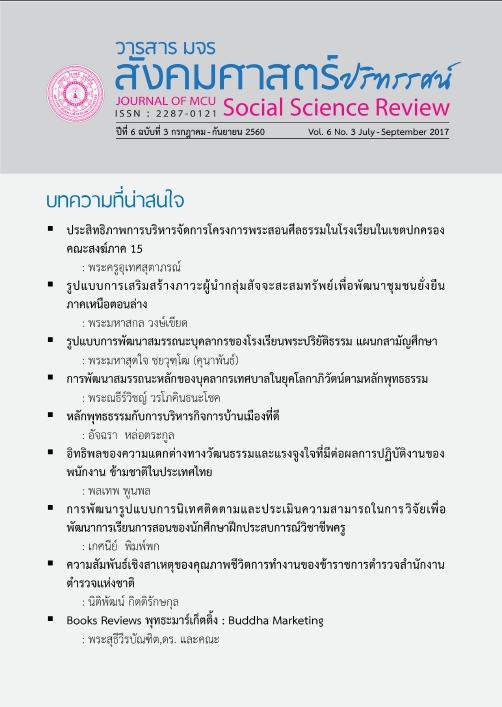การประยุกต์ลายผ้าฝ้ายของกลุ่มชาติพันธุ์ผู้ไทยในภาคอีสาน เพื่อพัฒนาผลิตภัณฑ์เชิงพาณิชย์
คำสำคัญ:
การประยุกต์ กลุ่มชาติพันธุ์ผู้ การพัฒนาผลิตภัณฑ์เชิงพาณิชย์บทคัดย่อ
บทความวิจัยนี้มีวัตถุประสงค์ คือ 1) เพื่อศึกษาประวัติความเป็นมาของลายผ้าฝ้ายของกลุ่มชาติพันธุ์ผู้ไทยในภาคอีสาน 2) เพื่อศึกษาสภาพปัจจุบันและปัญหาของลายผ้าฝ้ายของกลุ่มชาติพันธุ์ผู้ไทยในภาคอีสาน 3) เพื่อศึกษาแนวทางการประยุกต์ลายผ้าฝ้ายของกลุ่มชาติพันธุ์ผู้ไทยในภาคอีสานเพื่อพัฒนาผลิตภัณฑ์เชิงพาณิชย์ การวิจัยครั้งนี้เป็นการศึกษาโดยการใช้การวิธีวิจัยเชิงคุณภาพ ด้วยการใช้ แบบสำรวจ แบบสังเกต แบบสัมภาษณ์ และการประชุมเชิงปฏิบัติการ ศึกษาข้อมูลจากกลุ่มผู้รู้ กลุ่มผู้ปฏิบัติ และกลุ่มผู้ให้ข้อมูลทั่วไป รวม 120 คน ซึ่งได้คัดเลือกพื้นที่แบบเจาะจง 4 หมู่บ้าน คือ 1) กลุ่มชาติพันธ์ผู้ไทยบ้านโคกโก่ง 2) กลุ่มชาติพันธ์ ผู้ไทยบ้านกุดหว้า อำเภอกุฉินารายณ์ จังหวัดกาฬสินธุ์ 3) กลุ่มชาติพันธ์ผู้ไทยบ้านบะหว้า อำเภออากาศอำนวย จังหวัดสกลนคร และ 4) กลุ่มชาติพันธ์ผู้ไทยบ้านภู อำเภอโนนสูง จังหวัดมุกดาหาร นำเสนอผลการวิจัยเชิงพรรณนาวิเคราะห์
ผลการวิจัย พบว่า
ลายผ้าฝ้ายของกลุ่มชาติพันธุ์ผู้ไทยในภาคอีสาน ส่วนใหญ่ได้รับอิทธิพลจากธรรมชาติและสิ่งแวดล้อมในวิถีชีวิตของคนในท้องถิ่น ลายผ้าฝ้ายที่เกิดขึ้นได้สืบทอดให้ลูกหลานด้วยวิธีจดจำเป็นความสามารถเฉพาะตัวหรือเกิดจากภูมิปัญญาโดยแท้จริงไม่มีการจดบันทึกลายผ้าฝ้ายดั้งเดิมเป็นลายเรียบง่าย ได้แก่ ลายหมากจับ ลายขอ ลายนาคใหญ่ และลายงูลอย การประดิษฐ์ลวดลายใช้หลักการง่าย ๆ ไม่สลับซับซ้อน วิธีการโดยใช้เชือกกล้วยมัดลงบนเส้นฝ้ายที่จะใช้เป็นเส้นพุ่ง มัดลวดลายตามต้องการก่อนนำเส้นฝ้ายลงย้อมในสีคราม ล้างน้ำครามให้สะอาดนำไปตากแดดให้แห้ง แกะเชือกกล้วยออก ส่วนที่มัดไว้จะเป็นสีขาวธรรมชาติของเส้นฝ้ายและเกิดลวดลายตามต้องการนำไปทอเป็นผืนผ้าตามขั้นตอนการทอผ้าซึ่งได้สืบต่อกันมารุ่นต่อรุ่น
การประยุกต์ลายผ้าฝ้ายของกลุ่มชาติพันธ์ผู้ไทยบ้านโคกโก่ง บ้านกุดหว้า บ้านบะหว้า และบ้านภู เพื่อพัฒนาผลิตภัณฑ์เชิงพาณิชย์ โดยใช้วิธีการมัดหมี่ลายดั้งเดิมผสมผสานกับลวดลายที่จินตนาการขึ้นมาใหม่ตามสถานการณ์ เช่น ลายนาคข้ามโขง ลายไหลเรือไฟ และลายอื่น ๆ อีกมากมาย สร้างความสนใจให้ลูกค้าจนเป็นสินค้าขายดี แต่ประสบปัญหาวัตถุดิบหายากราคาแพง การออกแบบผลิตภัณฑ์ไม่หลากหลายเป็นการผลิตซ้ำ บรรจุภัณฑ์ ตราสินค้าไม่โดดเด่น ขาดความเป็นเอกลักษณ์และความรู้ด้านการขาย การตลาดยังมีน้อย องค์กรภาครัฐ ภาคชุมชน และผู้มีส่วนเกี่ยวข้องควรให้ความช่วยเหลืออย่างเร่งด่วน ทั้งนี้เพื่อส่งเสริมภูมิปัญญาและพัฒนาผลิตภัณฑ์ผ้าฝ้ายผู้ไทยในภาคอีสานให้เกิดมูลค่าเพิ่มมากยิ่งขึ้น
เอกสารอ้างอิง
Ministry of Education. (2551). Department of Academics, 2551 Basic Education Core Curriculum. Bangkok: Express Delivery Organization Printing House.
Pannee Sawetamarn. (2543). Study of Achievement of English Reading Taight by KWL PLUS and Teachers Manual (Master’s Thesis). Bangkok: Rankamhaeng University.
Phramaha Kamphon Khunangkaro. (2559). Human Resource Development in Buddhist Approach. Journal of MCU Social Science Review, 5(2), 387 – 396.
Rangsiman Suriyarangsan. (2554). Comprehensive Reading Exercise Form Development for the 1st Grade Secondary Students With Local Data of Petburi Province (Master’s Thesis). Bangkok: Silpakorn University.
Srivilai Polmanee. (2545). Language and Teaching. (4th edition). Chiengmai: Secondary Education Program, Faculty of Education, Chiengmai University,
Sunanta Mansertvit. (2545). Principle and Method of Thai Language Reading. Bangkok: Watanapanit Printing.
Suvit Moonkam and Oratai Moonkam. (2545). 21 Methods of Learning Management for Thinking Process Development. Bangkok: Parppim Limited Partnership Store.
Vatchara Laoriendee. (2547). Knowledge Management Technique for Professinal Teachers. Nakornpatom: Silpakorn University.
ดาวน์โหลด
เผยแพร่แล้ว
รูปแบบการอ้างอิง
ฉบับ
ประเภทบทความ
สัญญาอนุญาต
ลิขสิทธิ์ (c) 2018 วารสาร มจร สังคมศาสตร์ปริทรรศน์

อนุญาตภายใต้เงื่อนไข Creative Commons Attribution-NonCommercial-NoDerivatives 4.0 International License.
เพื่อให้เป็นไปตามกฎหมายลิขสิทธิ์ ผู้นิพนธ์ทุกท่านต้องลงลายมือชื่อในแบบฟอร์มใบมอบลิขสิทธิ์บทความให้แก่วารสารฯ พร้อมกับบทความต้นฉบับที่ได้แก้ไขครั้งสุดท้าย นอกจากนี้ ผู้นิพนธ์ทุกท่านต้องยืนยันว่าบทความต้นฉบับที่ส่งมาตีพิมพ์นั้น ได้ส่งมาตีพิมพ์เฉพาะในวารสาร มจร สังคมศาสตร์ปริทรรศน์ เพียงแห่งเดียวเท่านั้น หากมีการใช้ภาพหรือตารางหรือเนื้อหาอื่นๆ ของผู้นิพนธ์อื่นที่ปรากฏในสิ่งตีพิมพ์อื่นมาแล้ว ผู้นิพนธ์ต้องขออนุญาตเจ้าของลิขสิทธิ์ก่อน พร้อมทั้งแสดงหนังสือที่ได้รับการยินยอมต่อบรรณาธิการ ก่อนที่บทความจะได้รับการตีพิมพ์ หากไม่เป็นไปตามข้อกำหนดเบื้องต้น ทางวารสารจะถอดบทความของท่านออกโดยไม่มีข้อยกเว้นใดๆ ทั้งสิ้น





